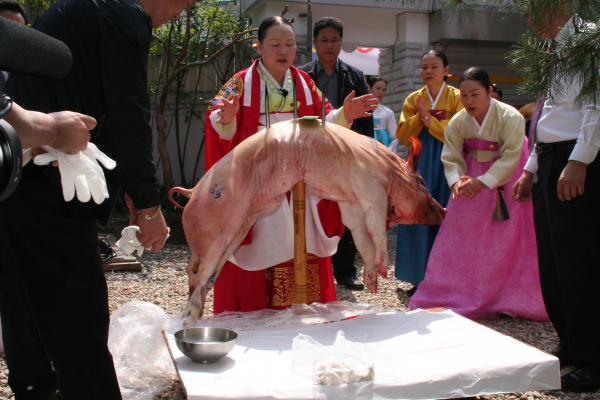한국무속신앙사전
서울굿의 용어로 ‘사슬’과 ‘세우기’의 합성어이다. 사슬은 옛말로 점이나 셈을 하는 산(算)[가지](/topic/가지)나 댓[竹]가지란 말이고, 세우기는 이 과정에서 월도와 창을 세우는 행위를 나타내는 말이다. 따라서 사슬세우기는 월도와 창을 세워 무엇인가를 알아보는 행위를 말한다. 그것은 곧 해당 신령이 이 굿을 잘 받으셨는지, 이른바 응감(應感)하셨는지를 알아보는 행위이다.
definition | 서울굿의 용어로 ‘사슬’과 ‘세우기’의 합성어이다. 사슬은 옛말로 점이나 셈을 하는 산(算)[가지](/topic/가지)나 댓[竹]가지란 말이고, 세우기는 이 과정에서 월도와 창을 세우는 행위를 나타내는 말이다. 따라서 사슬세우기는 월도와 창을 세워 무엇인가를 알아보는 행위를 말한다. 그것은 곧 해당 신령이 이 굿을 잘 받으셨는지, 이른바 응감(應感)하셨는지를 알아보는 행위이다. |
|---|---|
mp3Cnt | 0 |
wkorname | 김형근 |
| 정의 | 서울굿의 용어로 ‘사슬’과 ‘세우기’의 합성어이다. 사슬은 옛말로 점이나 셈을 하는 산(算)[가지](/topic/가지)나 댓[竹]가지란 말이고, 세우기는 이 과정에서 월도와 창을 세우는 행위를 나타내는 말이다. 따라서 사슬세우기는 월도와 창을 세워 무엇인가를 알아보는 행위를 말한다. 그것은 곧 해당 신령이 이 굿을 잘 받으셨는지, 이른바 응감(應感)하셨는지를 알아보는 행위이다. | 내용 | 서울굿에서 사슬은 두 차례 연행된다. 첫 번째는 산신도당거리에서이고, 두 번째는 대안주거리이다. 산신도당은 재수굿이나 [진적](/topic/진적)굿에만 존재하는 굿거리이고, 대안주는 오구굿에도 존재한다. 산신도당거리는 산거리·산바라기라고도 하고, 천궁불사맞이 다음에 행해지는 거리로서 산천에 있는 여러 신들과 지역신인 도당, 부군을 청배하고 놀리는 제차이다. 산신도당 12거리라고 해서 하나의 거리 안에 더 작은 거리들이 있다. 서울의 동쪽제는 천궁불사와 산신도당의 순서가 바뀐다. 실제로 1. 산신, 2. 도당, 부군, 3. 군웅, 4. 산신대신, 5. 산신호구, 6. 산신제장, 말명, 7. 산신신장, 8. 산신대감, 9. 산신창부, 10. 산신걸립, 서낭, 영산, 수비가 이 굿거리에서 차례대로 청배된다. 이때 산신, 도당, 부군 공수까지 마치면 사슬세우기를 한다. 처음에는 무구인 월도의 손잡이 부분을 바닥에 대고 세운다. 이를 “월도사슬, 빈사슬 세운다”라고 말한다. 빈사슬이 잘 서면 두 번째 [삼지창](/topic/삼지창)에 돼지를 얹어 세운다. 사슬을 세울 때 무당은 말로 신령에게 이 사슬을 잘 받아달라는 축원과 굿의 목적과 관련한 축원을 한다. 사슬이 잘 서면 술잔을 이 사슬에 한 바퀴 돌린 뒤 [재가집](/topic/재가집)에게 명과 복의 뜻으로 준다. 그리고 도당 [노랫가락](/topic/노랫가락)을 부른다. 대안주거리는 [관성제군](/topic/관성제군), 금성대군, 상산마누라, 별상, 신장, 대감을 아우르는 굿거리 명칭으로 서울굿에서는 그 위계가 높은 신격으로 관념된다. 대안주는 대거리(大巨里) 또는 댄주라고도 불리며 한 무당에 의해 위의 신격들이 차례대로 청배된다. 대안주는 ‘큰 안주’라는 의미로 [대안주상](/topic/대안주상)이 독립적으로 차려진다. 이 대안주상에 중요한 제물은 육고기이다. 소머리, 소갈비, 우족, 돼지족 등이 있는데 굿의 비용에 따라 가감이 된다. 대안주거리에서 사슬은 별상의 끝에 세운다. 대안주상 앞에서 앉아서 사슬을 세우는데, 산신도당에서처럼 빈사슬을 먼저 세운다. 한 번만 세우지 않고 여러 번 세우는데 첫 번째는 상산을 위한 몫으로 세우고, 뒤의 것은 굿을 하는 재가집 각각을 위해서 세운다. 그 다음 창에 소머리, 소갈비, 우족, 돼지족의 순서로 꽂아 세운다. 이는 별상과 대감을 위한 몫이다. 바치는 안주 각각이 어떤 신령의 몫인지에 대한 해석은 [만신](/topic/만신)마다 차이가 있다. 사슬세우기를 마치면 역시 산신도당거리에서처럼 명잔과 복잔을 내리고, 노랫가락을 부른다. 이렇게 보면 사슬세우기의 기능이 두 [가지](/topic/가지)임이 드러난다. 하나는 산신, 도당, 부군, 상산, 별상신에게 제물을 바치는 동시에 굿을 잘 받으셨는지의 여부를 묻는 것이다. 또 하나는 굿을 의뢰한 가족들의 길흉을 점치는 것이다. 한편 사슬세우기는 같은 강신무의 굿인 황해도굿에서도 존재한다. 세습무가 연행하는 동해안 굿에서도 사슬세우기와 유사한 행위가 존재하는데 [성주굿](/topic/성주굿)을 마치면서 [성주상](/topic/성주상)을 성주목에 세우는 행위가 그것이다. | 참고문헌 | 서울굿의 다양성과 구조 (김헌선, 한국무속학 12, 한국무속학회, 2006) 서울굿 ‘대안주거리’ 의 문화사적 의의 연구 (김헌선·김형근, 한국민속학 47, 한국민속학회, 2008) | Saseulseugi es un procedimiento de rituales chamánicos que se realizan en las áreas de Seúl, para averiguar algo erigiendo una lanza general o una lanza de media luna, conocida como woldo. El saseulseugi es una palabra compuesta que se forma por “saseul” y “seugi”. La palabra “saseul” se refiere a un tallo de bambú utilizado para el recuento o adivinación. En los rituales chamánicos se practican en las áreas de Seúl, el procedimiento de erección del palo se realiza como parte de los segmentos como “dodanggeori” y “byeolsanggeori”. Como paso inicial, se realiza un acto llamado “woldosaseul” que significa woldo levantado sobre su mango, o binsaseul que quiere decir “palo vacío”. Si la lanza queda erecta, el tridente llamado samjichang se usa para sostener al cerdo entero mientras el chamán hace oraciones rogando a los dioses que acepten el sacrificio y se haga el deseo realidad, propósito del ritual. Si la lanza de media luna se mantiene levantada con el cerdo entero encima, el chamán mueve una copa de licor alrededor de la lanza en un círculo completo, y luego pasa la copa a la familia que acoge el ritual como un signo de la longevidad y la buena suerte. El saseulseugi sirve a dos propósitos: el primero es ofrecer el sacrificio a Dodang que es la deidad provincial, la deidad de la oficina gubernamental llamada [[Bugun](/topic/DeidadConsagradaenlaOficinaGubernamental)](/topic/Bugun), Sangsan que se refiere a la alta montaña y Byeolsangsin que significa el dios de miembros fallecidos de la familia real y el segundo es indagar si ellos están satisfechos con el ritual para ofrecer una sesión de adivinación a la familia encargada del ritual. | 首尔[巫祭](/topic/巫祭)里将偃月刀和枪竖起来求神问卜的仪式。 “竖筹”是“筹”和“竖”的合成词。古代筹指占卜或术数中用的算筹或者竹筹;“竖”指该过程中将偃月刀和枪竖起来的动作。在首尔巫祭的都堂祭和别星祭中偶或竖筹。竖筹时,先把巫祭用具偃月刀的手柄挨着地面竖起来。这一步叫做“竖偃月刀筹,竖空筹”。若空筹已竖好,则开始第二步,将猪摆放在[三叉枪](/topic/三叉枪)上。在竖筹的过程中,巫师向神灵祈福,请神歆享,并禀告巫祭的目的。若筹已竖好,巫师执酒杯绕筹转一圈后,将酒杯交给主家,祝福寿双全。 竖筹有两个目的:一是向[都堂神](/topic/都堂神),[府君](/topic/府君),上[山神](/topic/山神),别相神(音)上供祭品,问其对巫祭仪式是否满意;二是占卜约请巫祭的主家的吉凶。 | Saseulseugi is an inquiry procedure in shamanic rituals in the Seoul area, carried out by erecting a knife and spear. The ancient term saseul refers to a bamboo stick used for counting or divination. In shamanic rituals in the Seoul area, the stick-erecting procedure is held as part of the provincial deity ritual segment (dodanggeori) and segment for the deceased royalty god (byeolsanggeori). First, the moon knife (woldo) is erected on its handle, which is referred to as woldosaseul (moon knife stick) or binsaseul (empty stick). If the knife stays erect, the three-pronged spear samjichang is used to hold up a whole pig, during which the shaman chants a prayer asking the gods to accept this sacrifice and about the purpose of the ritual. If the spear with the pig stays erect, the shaman moves a cup of wine around the spear in full circle, then hands the cup to the family hosting the ritual as a sign of longevity and good fortune. Saseulseugi serves two purposes: First, for offering a sacrifice to Dodang ([Provincial Deity](/topic/ProvincialDeity)), [[Bugun](/topic/GovernmentOfficeDeity)](/topic/Bugun) (Government Office Deity), Sangsan (High Mountain) and Byeolsang (Deceased Royalty God), and to inquire if they are satisfied with the ritual; and second, for performing divination for the family that has commissioned the ritual. |
|---|
| 사슬세우기 |  64702 사슬세우기 |
|---|---|
| 사슬세우기 |  64701 사슬세우기 |
0 Comments














